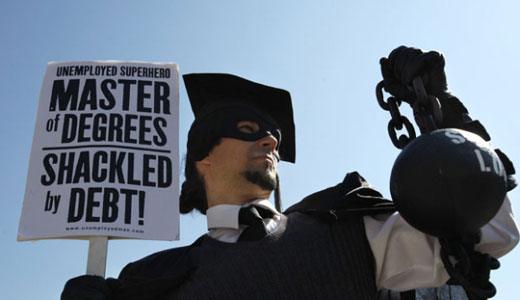
CHICAGO – On July 1 interest rates for federally subsidized Stafford Loans will double for 7.4 million students unless Congress takes action. If the rates double from 3.4 percent to 6.8 percent, students will pay on average $1,500 more a year for each loan.
Without an agreement the growing student debt crisis will only deepen. The 2013 graduating class leaves school with an average crushing debt load of $27,000.
“This is a really scary number, considering these students have no money and no established credit,” said Tiffany Dena Loftin, president of United States Student Association (USSA). (Follow this link to hear audio from the People’s World national teleconference with Tiffany Dena Loftin.)
A short term solution to avert a rate hike July 1 seemed more and more unlikely, Loftin told Campaign for America’s Future. No agreement could spark more students to get involved in the fight for a real long term solution.
USSA, Student Debt Crisis, state and local student coalitions and other groups are ratcheting up pressure on Congress as the July 1 deadline looms to come up with a solution.
“We are asking students and their parents to make their stories heard to their elected officials. Don’t be ashamed to open up about your debt. Sign petitions and visit the local offices of your legislators,” said Loftin who graduated from University of California – Davis $28,000 in debt.
With the clock ticking, Congress has been unable to reach agreement over several competing bills. House Republicans are refusing to budge off their determination to make students pay “market rates” for loans, a concept contained in the Smarter Solutions for Students Act, which passed the House earlier this month.
The bill pegs loan rates to the 10-year US Treasury note plus 2.5 percent. While that rate is low now, it would rise if the economy improves. Loan interest would be capped at 8.5 percent.
Parents and graduate student borrowers would pay even higher rates.
President Obama supports a fixed loan tied to the 10-year treasury note with no cap. However, graduates would pay no more than 10 percent of their income in monthly installments.
A bill introduced by Senators Jack Reed, D-RI, and Tom Harkin, D-IA, would freeze the interest rates at 3.4 percent for two years and “pay for them” by closing corporate tax loopholes.
However the legislation generating the most excitement is Sen. Elizabeth Warren‘s, D-Mass., bill called the Bank on Students Act. It has garnered a number of co-sponsors and the support of dozens of groups and institutions. The bill would offer federal student loans at .75 percent, the same rate the Federal Reserve offers to the biggest banks for the next two years.
“The federal government makes 36 cents on every dollar it lends to students,” said Warren. “Congressional Budget Office announced that the government will make $51 billion on the student loans it issued this year – more than the annual profit of any Fortune 500 company, and about five times Google’s yearly earnings. We should not be profiting from students who are drowning in debt while we are giving great deals to big banks.”
None of the legislation covers lending by Sallie Mae or other private lenders.
(story continues after video)
Some 39 million borrowers now hold an accumulated student debt over $1.1 trillion which has doubled since 2007 and is larger than consumer credit card debt. Debt repayment is becoming a major drag on the economy as young people buy less homes and cars.
“It’s not like the old days. Today’s students are bearing debts that past generations couldn’t dream of having. In the past ten years, student debt has tripled. That’s why we are pushing senators not to allow the rates to double on July 1.” Courtney Hayes, University of Missouri St. Louis, student senator and Vice President of Young Activists United UMSL
The situation is made worse because students are graduating into a stagnant economy with high joblessness for young workers and declining real wages, making it harder to repay loans.
However current legislation is unlikely to alleviate the student debt crisis long term. The cost of going to college is skyrocketing, rising 1,120 percent over the past 30 years. Tuition, room and board have gone up over 30 percent over the past 10 years at private nonprofit colleges, and 42 percent at public universities.
Millions of graduates are already struggling with a lifetime of student loan debt. Student loan borrowers cannot relieve their debt by filing for bankruptcy. Among people under 30 years old, 35 percent are near default.
“This problem is much bigger than interest rates,” said Loftin. “It’s about college affordability, the ability of students to actually go to college, finish college and pay back their student loans afterwards. The fight goes on.”
Call your senators and representatives at their home offices and Capitol Hill: (202) 224-3121
Photo: Jacquelyn Martin/AP

MOST POPULAR TODAY


Zionist organizations leading campaign to stop ceasefire resolutions in D.C. area

High Court essentially bans demonstrations, freedom of assembly in Deep South

Afghanistan’s socialist years: The promising future killed off by U.S. imperialism

Communist Karol Cariola elected president of Chile’s legislature






Comments